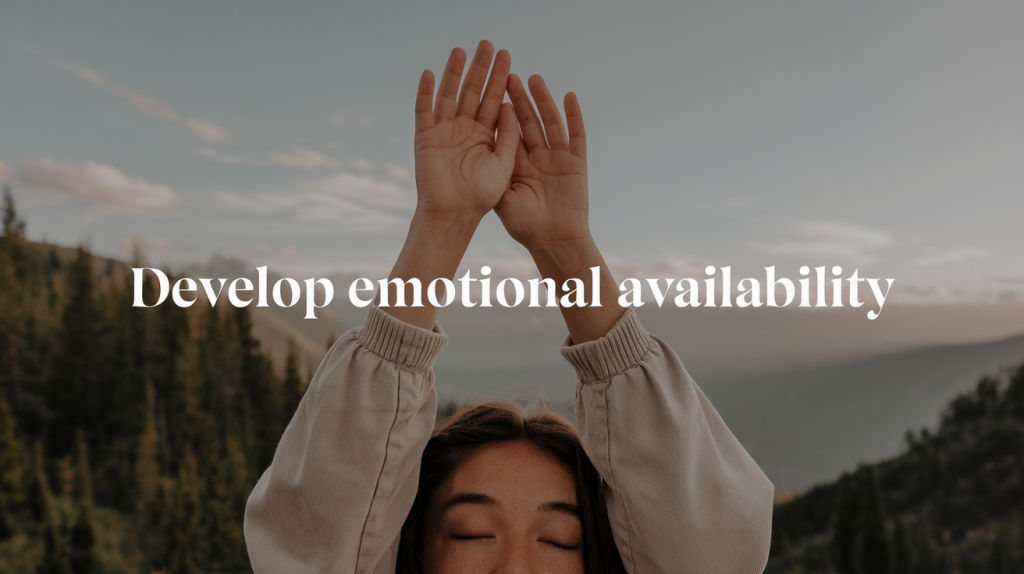Do you find it hard to share feelings with others? When someone opens up, you might feel the urge to step back.
Many people struggle with being open in relationships, often because they learn to keep their emotions hidden.
But there’s good news – becoming more emotionally available is a skill anyone can learn. This guide will show you practical steps to open up and connect with others in a meaningful way.
You’ll learn how to recognize your patterns, build trust gradually, and express your feelings clearly.
Let’s look at simple techniques that can help you create stronger bonds with the people in your life.
The Importance of Being Emotionally Available

Being emotionally available helps build lasting connections with others. When people share their true feelings, it creates trust and understanding in relationships.
This openness allows for honest conversations about hopes, fears, and needs.
Someone who can express emotions freely tends to form deeper bonds with family members, friends, and romantic partners.
The ability to stay present during difficult conversations shows others they matter. By listening without judgment and responding with care, relationships become stronger.
Emotional availability also helps in managing conflicts better – when both people can talk about their feelings openly, they find solutions more easily.
This skill affects all areas of life – from personal relationships to work interactions. People who share their emotions tend to feel less stressed and more satisfied with their connections.
They often report better mental health and lower anxiety levels. Being emotionally available also helps in understanding personal needs and setting healthy boundaries with others.
Certain Ways to Become Emotionally Available
Becoming emotionally available involves understanding and practicing certain behaviors that foster deeper connections and trust. Here are some key ways to achieve emotional availability.
1. Notice Personal Patterns

Past experiences shape how people connect with others. Taking time to notice these patterns helps in understanding reactions to emotional situations.
Writing down thoughts and feelings each day can make these patterns clearer. Looking at past relationships and seeing similar behaviors that repeat can provide useful insights.
These patterns might appear in work relationships, friendships, and family connections. Taking notes about emotional reactions in different situations can reveal important information.
Understanding these patterns takes time, but the insights gained make the effort worthwhile.
2. Start Small with Trust

Building trust happens step by step. Starting with small disclosures makes the process feel safer. Sharing minor concerns or daily experiences creates a foundation for bigger conversations.
This gradual approach helps build confidence in being more open. Testing the waters with trusted friends or family members can make the process feel more natural and less overwhelming.
Simple sharing might include talking about a book that moved you or describing how a situation at work made you feel.
The key is to move at a comfortable pace and recognize that each small step builds toward better emotional connections.
3. Practice Active Listening

Good listening creates space for emotional connections. Paying attention to what others say without planning responses shows real interest.
Making eye contact and nodding shows engagement in the conversation. Asking questions about what someone shares helps them feel understood.
This skill builds stronger connections and makes others feel valued. The practice of active listening includes giving others time to complete their thoughts without interruption.
Sometimes, simply being quiet and offering supportive gestures can help others open up more. This type of attention shows others their feelings matter and creates trust in relationships.
4. Express Feelings with Words

Putting feelings into words takes practice. Starting with basic emotions like happy, sad, or angry helps build an emotional vocabulary.
Speaking about feelings regularly makes it more comfortable over time. Using simple statements like “I feel…” helps express emotions clearly.
Regular practice makes this skill more natural and comfortable. The process might feel strange at first, but with time it becomes easier to name and share feelings.
Writing feelings down before sharing them can help organize thoughts and make expressing them feel less overwhelming. This skill grows stronger with each honest conversation.
5. Stay Present in Conversations

Being present means giving full attention during conversations. Setting aside phones and other distractions shows respect for the moment.
Focusing on the current conversation instead of thinking about other tasks helps build real connections.
This attention creates space for meaningful exchanges and deeper understanding. Taking deep breaths can help maintain focus when minds start to wander.
Creating a habit of presence in daily talks builds better listening skills over time. Small acts of attention show others their words matter and help create stronger bonds.
6. Accept All Emotions

Understanding that all feelings have value helps in becoming more open. Accepting both positive and challenging emotions as normal parts of life reduces judgment.
This acceptance makes it easier to share feelings with others. Learning to sit with uncomfortable emotions without trying to fix them right away builds emotional strength.
Recognizing that feelings come and go like waves can make them feel less overwhelming.
Accepting emotions doesn’t mean acting on every feeling but rather acknowledging their presence without shame. This acceptance creates room for honest self-expression and deeper connections.
7. Set Clear Boundaries

Having good boundaries makes being emotionally open feel safer. Knowing personal limits and expressing them clearly helps maintain healthy relationships.
Good boundaries include saying no when needed and respecting others’ limits. This balance creates safe spaces for sharing feelings and building trust.
Setting boundaries might feel uncomfortable at first, but it becomes easier with practice. Clear limits actually help relationships grow stronger by creating respect and understanding.
Good boundaries allow for emotional sharing while maintaining personal space and comfort.
8. Take Responsibility for Feelings

Understanding that each person owns their emotions helps in expressing them better. Learning to share feelings without blaming others creates better conversations.
Taking responsibility means using “I” statements when talking about emotions. This approach helps avoid defensive reactions and builds better understanding.
Owning feelings includes recognizing that others aren’t responsible for making you feel better.
This responsibility creates freedom to work through emotions in healthy ways. Personal ownership of feelings leads to more honest and open relationships.
9. Create Safe Spaces

Making time for meaningful conversations helps build emotional openness. Taking time to slow down allows for meaningful conversations.
Setting aside regular time for important talks shows commitment to emotional growth. Creating these opportunities makes sharing feelings feel more natural.
These spaces might be physical places or simply dedicated time for connection. Regular check-ins with important people help maintain emotional bonds and create trust.
Making space for feelings shows others they matter and helps build lasting connections.
10. Learn from Feedback

Being open to hearing how others experience the relationship helps growth. Taking in feedback about communication styles can show areas for improvement.
Using this information to make small changes helps build better connections. This openness to learning strengthens relationships over time.
Asking specific questions about how to communicate better shows a willingness to grow. Each piece of feedback offers a chance to understand others more clearly.
This learning process helps create stronger and more meaningful relationships.
11. Seek Support When Needed

Asking for help shows strength, not weakness. Finding support through friends, family, or professionals can guide emotional growth.
Sharing challenges with trusted people makes everything easier. This support system provides encouragement and guidance when facing difficult emotions.
Professional help can offer new tools and perspectives for emotional growth. Having multiple sources of support creates a stronger foundation for personal development.
Remember that seeking help is a sign of wisdom and self-awareness, not failure.
Signs You May Be Emotionally Unavailable

- Changing the Subject: People who struggle with emotional availability often change the topic when conversations turn personal. This helps them avoid discussing deeper feelings or experiences.
- Using Humor to Deflect: Some individuals use humor to sidestep serious topics. This tactic helps them maintain emotional distance and avoid vulnerability in conversations.
- Keeping Busy to Avoid Deep Interactions: A busy schedule can be a strategy to avoid emotional connection. By staying occupied, they limit opportunities for deep, personal interactions.
- Physical Discomfort During Emotional Moments: Emotional discomfort may manifest physically, like feeling tense or uneasy when others express their feelings. This response signals avoidance of emotional engagement.
- Avoiding Important Discussions: During significant discussions, some people may remain silent or physically leave the room. This is often an attempt to avoid engaging with emotionally charged topics.
- Distracting with Technology: Focusing on a phone or other distractions during meaningful conversations is a common behavior. It allows individuals to detach from emotional moments and avoid connection.
- Surface-Level Relationships: People with difficulty being emotionally available tend to keep their relationships shallow. They engage in casual discussions but avoid sharing personal thoughts or feelings.
- Few Close Connections: While they may have many acquaintances, these individuals often lack deep, close friendships. The relationships they maintain are typically limited to surface-level interactions.
How Emotional Availability Improves Relationships
Emotional availability strengthens bonds between people in meaningful ways. When someone can share their true feelings, it helps others feel safe to do the same. This creates a cycle of honest communication where both people feel heard and understood.
Emotional availability leads to better conflict resolution in romantic relationships. Partners who express their feelings clearly can work through problems more effectively. They understand each other’s viewpoints and find solutions that work for both people.
This openness also builds trust, as each person knows they can count on the other for support during difficult times.
Family relationships benefit from emotional availability, too. Parents who show their feelings help children learn to express themselves, and friends who share openly create lasting bonds based on trust and understanding.
This skill also helps in work relationships, where clear communication leads to better teamwork and fewer misunderstandings.
The practice of being emotionally available creates space for genuine connections in all types of relationships.
Conclusion
Building emotional availability takes time and consistent effort. This guide’s steps offer a clear path toward opening up and connecting with others.
From noticing personal patterns to seeking support when needed, each step helps create stronger and more meaningful relationships.
Small changes in daily habits can make a big difference in how people connect with others.
Being emotionally available can positively change all relationships—with family, friends, romantic partners, and coworkers.
Ready to start? Begin with one small step today.
Try sharing a feeling with someone trusted or practice listening without planning what to say next.
Remember, the goal isn’t perfection – it’s progress toward better connections with others.
Frequently Asked Questions
How to Tell if I’m Emotionally Unavailable?
You avoid deep conversations, feel uncomfortable with emotions, keep relationships superficial, and often pull away when others try to get closer.
What Attracts Emotionally Unavailable?
People with low self-worth often seek emotionally distant partners, repeating patterns from childhood where love felt hard to reach.
What is the Root Cause of Emotional Unavailability?
Past hurts, especially from childhood, teach people to protect themselves by keeping emotions hidden and avoiding close bonds with others.








